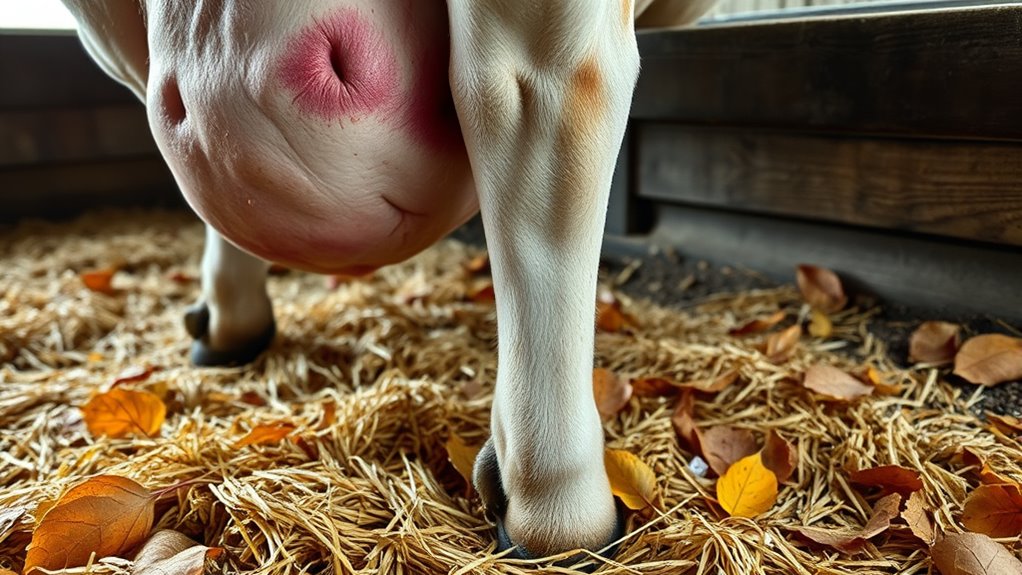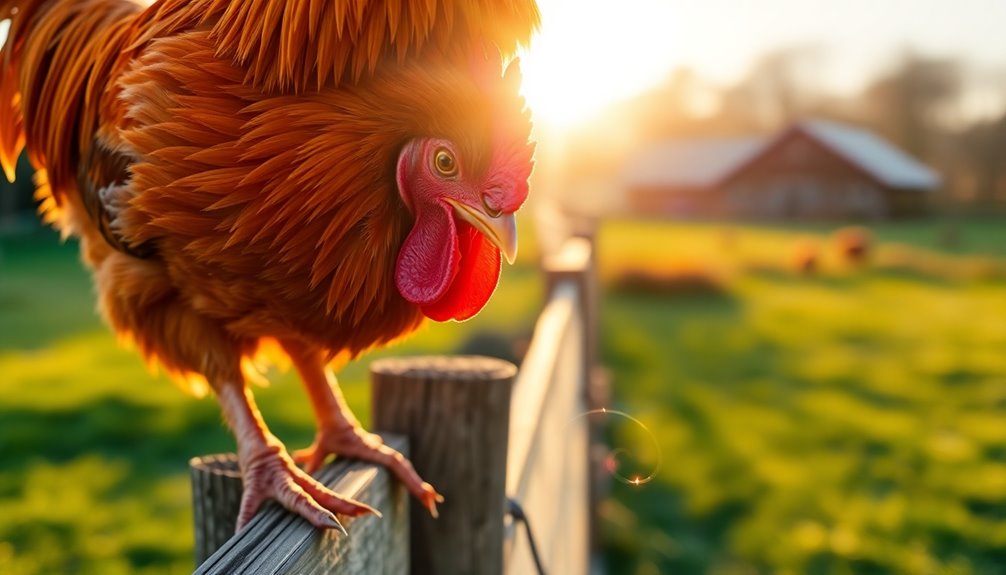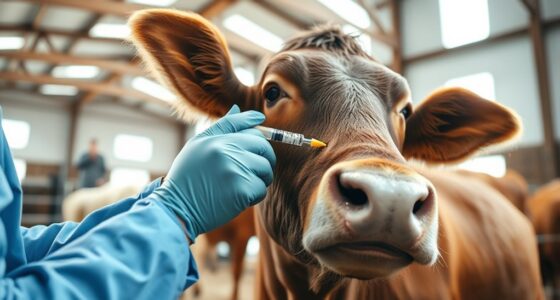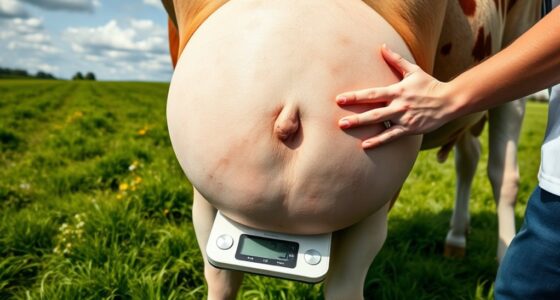During autumn weather swings, you should watch for physical signs like udder swelling, heat, firmness, or lumps, and check for abnormalities in the milk such as discoloration or watery consistency. Monitoring somatic cell counts and using automated sensors can help detect subclinical mastitis early. Keep an eye on cow behavior and maintain regular udder checks, as proactive management makes a big difference. Continue exploring to discover more key strategies for early detection and effective prevention.
Key Takeaways
- Regularly inspect the udder for swelling, heat, firmness, lumps, or discomfort signs during weather changes.
- Monitor milk for abnormalities like clots, discoloration, or reduced yield to detect early infection.
- Use somatic cell counts and automated sensors for real-time detection of subclinical mastitis.
- Watch for behavioral changes such as reduced activity or social withdrawal indicating early health issues.
- Maintain udder hygiene and manage pasture rotation to minimize environmental risk factors during weather fluctuations.
Recognizing Physical Changes in the Udder and Milk

During autumn weather, recognizing physical changes in the udder and milk is essential for early mastitis detection. Pay close attention to signs like swelling, heat, or firmness, which can indicate infection. Maintaining proper udder hygiene before and after milking reduces bacteria buildup, lowering mastitis risk. During each milking routine, check for abnormalities such as clots, discoloration, or a watery appearance in the milk. Consistent observation helps you spot early changes before they worsen. Keep the udder clean and dry, especially as weather shifts cause moisture buildup. Monitoring color accuracy in milk appearance can also serve as an additional indicator of potential issues. Additionally, understanding early detection signs can help prevent severe infections. Recognizing physical changes quickly allows you to protect your herd’s health and maintain high-quality milk production. Adopting preventative measures such as proper milking techniques and hygiene practices further supports early detection efforts. Regularly inspecting the udder for clinical signs can enhance your ability to identify problems promptly. Incorporating veterinary consultations during unusual cases can also improve early intervention strategies.
Monitoring Milk Quality and Composition
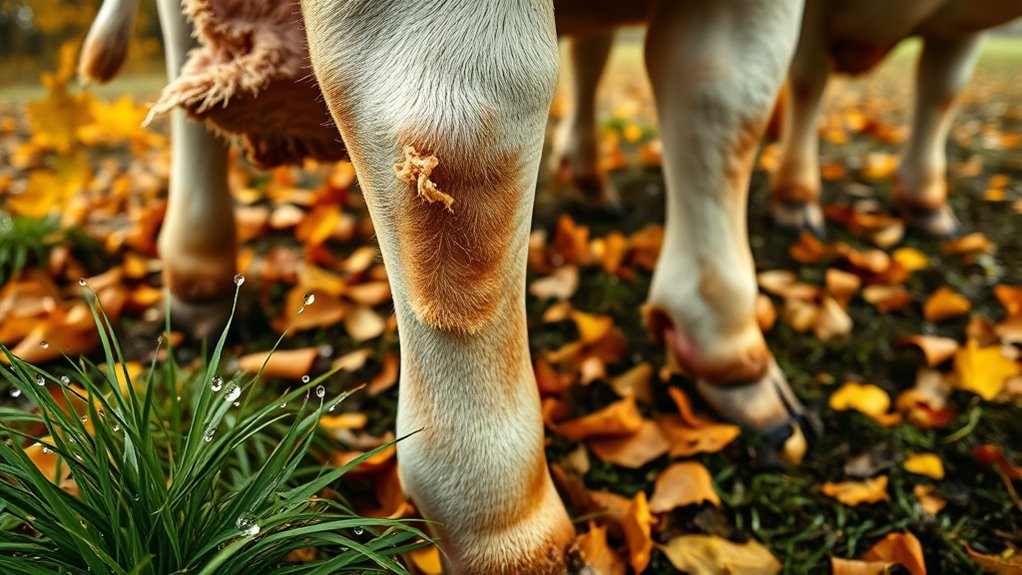
Monitoring the quality and composition of milk provides essential insights into herd health and helps detect early signs of mastitis that might not be visible physically. You should regularly analyze milk for factors like somatic cell count, fat, protein, and lactose levels. Changes in these components can indicate underlying issues, especially when combined with knowledge of genetic factors affecting susceptibility. Additionally, tracking feed intake helps you understand how nutrition influences milk composition and immune response. Sudden drops in feed intake may signal discomfort or illness, prompting further investigation. By consistently monitor these parameters, you can identify subtle shifts early, allowing for prompt intervention. Incorporating advanced testing methods can improve detection accuracy and early diagnosis. This proactive approach ensures healthier animals, improves milk quality, and reduces the risk of mastitis progressing during autumn weather swings.
Using Somatic Cell Counts for Early Detection

Somatic cell count (SCC) is a vital indicator for early detection of mastitis, often rising before symptoms become visible. Regular SCC testing allows you to identify subclinical infections early, preventing severe cases. Incorporate genetic screening to select cows with lower genetic predisposition for high SCC, improving herd resilience. Effective pasture management also plays a role; rotating grazing areas reduces environmental exposure that can elevate SCC levels. Consistent monitoring helps you spot trends tied to weather swings in autumn, when environmental stress may increase SCC. By tracking SCC data, you can implement targeted interventions, such as adjusting milking routines or enhancing cleanliness, to curb mastitis development. Utilizing automation’s role in business intelligence can further enhance data analysis and decision-making processes. Combining SCC monitoring with genetic and pasture strategies gives you a proactive approach to maintaining udder health and milk quality. Additionally, understanding how diverse planters and watering pots can optimize farm infrastructure may indirectly support healthier environments for dairy animals.
Observing Behavioral and Health Indicators
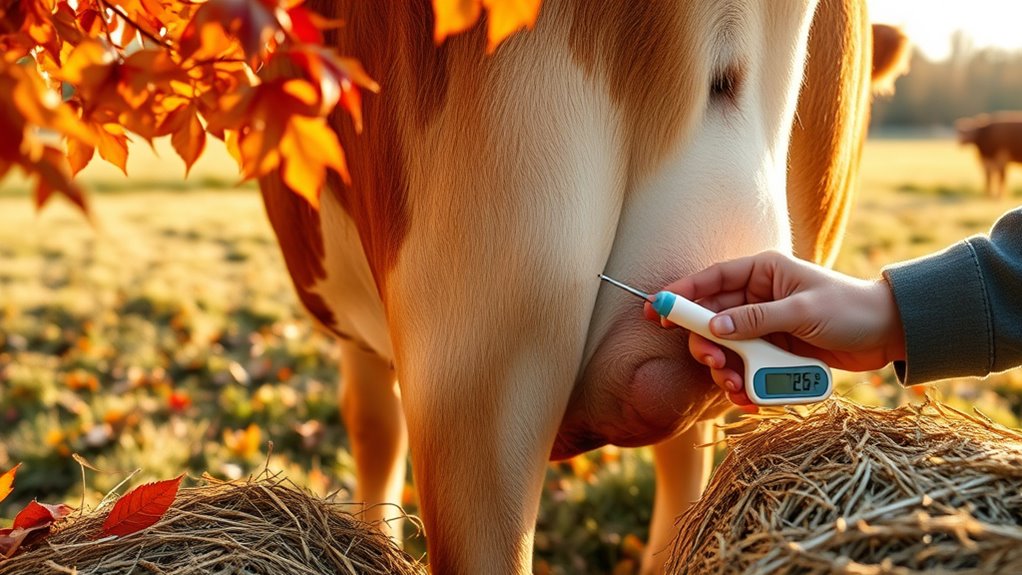
You should watch for changes in your cows’ behavior, such as decreased activity or reluctance to move. Keep an eye out for physical symptoms like swelling or heat in the udder. Noticing these signs early can help you catch mastitis before it worsens. Additionally, being aware of early detection methods can improve treatment outcomes and animal welfare. Utilizing advanced machine learning algorithms can assist in identifying subtle behavioral changes indicative of mastitis. Incorporating preventive measures into your herd management can further reduce the risk of mastitis development during fluctuating autumn weather patterns.
Changes in Cow Behavior
As autumn weather sets in, cows often exhibit subtle changes in their behavior that can signal the onset of mastitis. You might notice a decrease in pasture grazing, as cows become less interested in their usual activity. Feed intake may also drop, indicating discomfort or illness. Monitor for signs like restlessness or increased lying time, which suggest discomfort. Keep an eye on social interactions; cows may isolate themselves or become less responsive. Changes in behavior, such as reduced grazing or feed consumption, are early clues you shouldn’t ignore. Recognizing these shifts allows you to intervene promptly, reducing mastitis severity and maintaining herd health. Additionally, paying attention to immune response variations can help identify early infections before clinical signs become severe. Being aware of environmental factors that influence cow health during seasonal changes can further aid in early detection and prevention efforts. Observing behavioral changes can also help you better understand your herd’s overall well-being and respond proactively. Incorporating regular health checks and monitoring for subclinical signs can improve early detection and treatment strategies. Proper management of seasonal transitions can reduce stress and support overall herd resilience.
Monitoring Physical Symptoms
How can you effectively identify early signs of mastitis through physical symptoms? Start by closely monitoring your cows for swelling, heat, or pain in the udder, which are clear indicators. Look for abnormal milk—such as discoloration, clots, or a drop in yield—that signals infection. Keep in mind that genetic factors can influence susceptibility, so some cows may show symptoms earlier than others. Nutritional strategies also play a role; ensuring proper mineral and vitamin intake supports immune function and helps prevent mastitis. Regular physical examinations, combined with knowledge of these factors, enable you to catch issues early. Being aware of special occurrences such as weather swings can also help you anticipate and recognize early signs of mastitis. Prompt detection allows for quicker intervention, reducing severity and protecting your herd’s health during tricky autumn weather swings. Additionally, understanding infection risk factors can aid in implementing preventive measures to minimize outbreaks. Recognizing the cycle of breakups in herd health patterns can help you identify recurring issues and address underlying causes before they escalate. Staying informed about security measures such as surveillance can also help prevent theft or vandalism that might stress your herd, indirectly affecting health.
Implementing Regular Visual and Palpation Checks
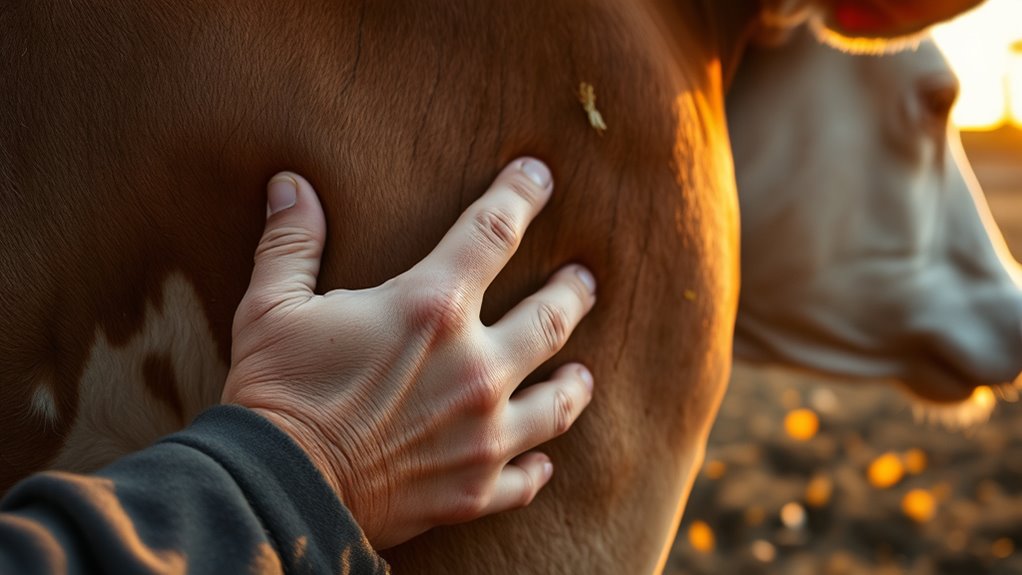
You should perform daily udder inspections and touch assessments to catch issues early. Consistent checks help you notice early warning signs like swelling or heat. By staying vigilant, you can address problems before they develop into full-blown mastitis. Additionally, understanding data privacy challenges can inform how you securely handle sensitive health information during monitoring. Regularly updating your monitoring procedures ensures you stay ahead of potential issues while safeguarding farmer and animal data.
Daily Udder Inspections
Are you regularly inspecting your herd’s udders to catch early signs of mastitis? Daily udder inspections are essential for effective seasonal management and climate adaptation, especially during autumn weather swings. By visually checking and palpating udders, you can spot swelling, heat, or abnormalities early. This proactive approach helps prevent severe infections and minimizes milk production issues. Make it a routine to observe for changes in udder texture or color, and feel for lumps or firmness. Consistent inspections allow you to adapt quickly to changing weather conditions, reducing the risk of mastitis. Remember, early detection is key to maintaining udder health and overall herd productivity. Incorporate these checks into your daily routine to stay ahead of potential problems.
- Look for swelling or heat
- Check for abnormal color or discharge
- Feel for lumps or hardness
- Observe milk let-down response
- Record any unusual findings
Consistent Touch Assessments
Implementing regular visual and palpation checks guarantees consistent monitoring of udder health, especially during the unpredictable autumn weather. By routinely touching the udder, you can detect early signs of mastitis, such as swelling, heat, or unusual firmness. Maintaining good udder hygiene during these assessments helps prevent infections from taking hold. Pay attention to how feed intake might influence udder condition, as decreases can signal health issues. Consistent assessments allow you to notice subtle changes over time, making early intervention possible. Incorporate these touch checks into your daily routine, ensuring they become a habit. This proactive approach helps identify problems before they worsen, reducing the risk of severe mastitis and maintaining overall udder health during the changing seasons.
Early Warning Signs
Regular visual and palpation checks help you spot early warning signs of mastitis before they develop into serious issues. By paying close attention, you can identify subtle changes that may indicate infection or discomfort. Watch for signs like swelling, heat, or firmness in the udder, especially if genetic predispositions make certain cows more vulnerable. Nutritional deficiencies can also weaken the immune system, increasing mastitis risk. Regular checks enable prompt intervention, reducing treatment costs and milk loss. Remember, early detection is key during autumn weather swings when temperature fluctuations can hide symptoms. Stay vigilant and incorporate these practices into your routine:
- Swelling or hard spots in the udder
- Unusual warmth or heat
- Changes in milk color or consistency
- Cow showing signs of discomfort or pain
- Increased somatic cell count
Utilizing Technology and Automated Monitoring Tools

As autumn weather brings fluctuating temperatures and humidity levels, using technology and automated monitoring tools can considerably enhance mastitis detection. Modern sensors and milk analyzers track changes in somatic cell counts and milk conductivity, providing real-time alerts that help you catch early signs. Automated systems can also analyze genetic markers linked to mastitis susceptibility, enabling targeted interventions. Nutritional strategies supported by monitoring data optimize cow health and immune responses during weather swings. Wearable devices monitor activity and rumination patterns, revealing early discomfort or stress. Integrating these tools into your herd management allows for quicker responses, reducing the risk of severe infections. Embracing technology ensures more precise, proactive detection, ultimately safeguarding your herd’s health during autumn’s unpredictable weather.
Adjusting Management Practices for Weather-Related Risks
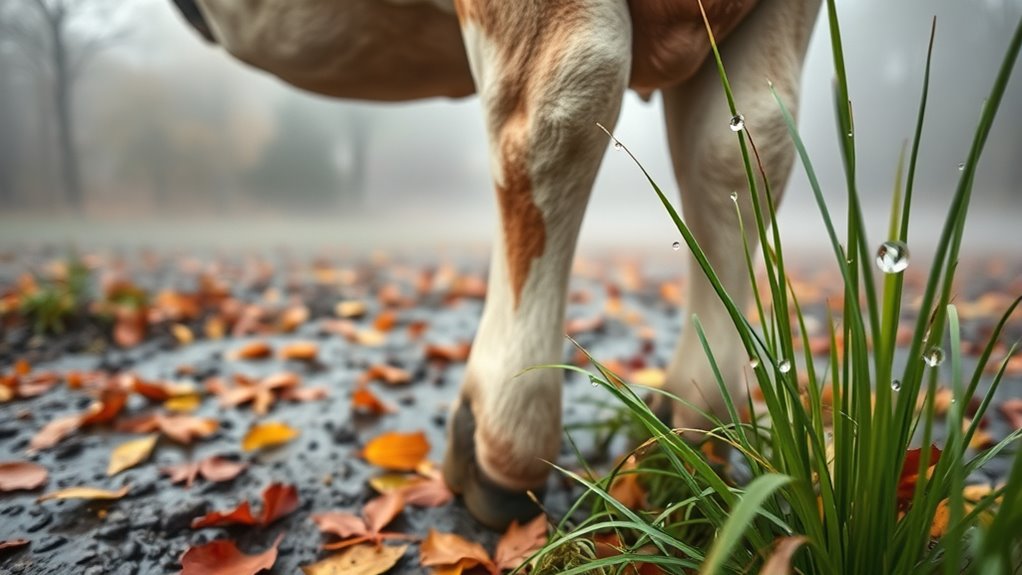
Since autumn weather can cause sudden shifts in temperature and humidity, adjusting your management practices is essential to protect your herd from mastitis risks. Climate adaptation involves modifying housing, ventilation, and bedding to reduce stress and moisture buildup. Nutritional adjustments are also key; increasing energy and antioxidant levels helps boost immunity during unpredictable weather. You should:
- Monitor environmental changes daily
- Improve airflow to prevent condensation
- Provide balanced diets with added vitamins
- Ensure clean, dry bedding at all times
- Adjust milking routines to minimize stress
Implementing these practices helps your herd adapt to autumn weather swings, reducing mastitis incidence. Staying proactive with climate adaptation and nutritional adjustments guarantees your cows stay healthy and productive despite the weather challenges.
Frequently Asked Questions
How Does Humidity Influence Early Mastitis Detection?
Humidity influences early mastitis detection because humidity fluctuations can mask or mimic symptoms, creating detection challenges. When humidity levels change rapidly, it affects udder comfort and milk quality, making it harder to spot early signs like swelling or heat. You might find it tricky to distinguish between normal moisture variations and infection symptoms, so monitoring humidity and being vigilant helps improve detection accuracy during these weather shifts.
Can Feed Changes Affect Mastitis Signs During Autumn?
Feed management can considerably influence mastitis signs during autumn, as sudden changes may stress your herd and affect their immune response. When you adjust diets, watch for stress indicators like decreased milk production or altered behavior, which could mask or mimic mastitis symptoms. Maintaining consistent feeding routines helps reduce stress, making it easier to identify actual mastitis early. Proper feed management is key to keeping your cows healthy and detecting issues promptly.
Are There Specific Breeds More Susceptible in Seasonal Shifts?
You might think all breeds handle seasonal shifts the same, but some are more susceptible to mastitis due to breed susceptibility and seasonal vulnerability. Dairy breeds like Jersey and Guernsey are often more prone to mastitis during weather changes, so you should keep a close eye on them. Being aware of these breed differences helps you stay ahead, as the early bird catches the worm when it comes to mastitis management.
How Does Early Mastitis Impact Overall Herd Productivity?
Early mastitis can considerably reduce your herd’s milk yield and compromise cow health. When infection strikes early, it leads to decreased milk production and potential long-term health issues for your cows. Prompt detection helps prevent severe impacts, ensuring your herd remains productive and healthy. By monitoring signs closely, you can address mastitis swiftly, maintaining ideal milk yield and supporting overall herd well-being.
What Role Do Environmental Pathogens Play in Autumn Mastitis Outbreaks?
Environmental pathogens play a significant role in autumn mastitis outbreaks by thriving in environmental reservoirs like bedding, manure, and water sources. As weather fluctuates, pathogen survival increases, raising the risk of infection. You need to monitor these reservoirs closely, maintain cleanliness, and guarantee proper ventilation to reduce pathogen exposure. By controlling these environmental factors, you lower the chances of early mastitis, protecting your herd’s health and productivity.
Conclusion
By staying vigilant and monitoring your herd closely, you can catch early signs of mastitis before it becomes a nightmare. Pay attention to physical changes, milk quality, and behavior shifts—these tiny clues are your best allies. Using technology and adjusting your management practices during autumn weather swings will keep mastitis at bay. Remember, with consistent care, you can prevent issues so severe they’ll seem like a herd disaster—stay proactive and protect your dairy’s health!

